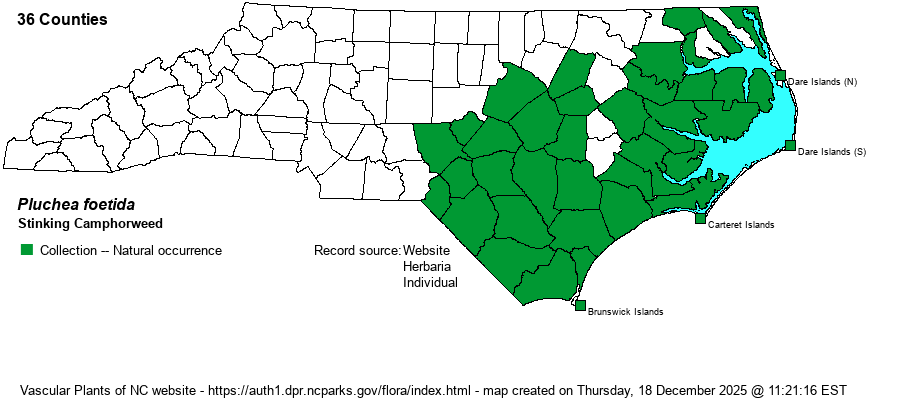| Author | (L.) de Candolle | |
| Distribution | Coastal Plain and Outer Banks; scarce in the Sandhills proper. Virtually absent from the adjacent Piedmont.
Coastal Plain, NJ to southern FL, eastern TX, and southeastern OK. | |
| Abundance | Common in the lower half of the Coastal Plain, but infrequent to locally fairly common in the Sandhills, the northern Coastal Plain, and other parts of the inner Coastal Plain. | |
| Habitat | Freshwater marshes, fresh-tidal marshes, interdune marshes and pondshores, blackwater river back-up channels, clay-based Carolina bays, roadside ditches, borrow pits. | |
| Phenology | Flowering and fruiting late July-October. | |
| Identification | Camphorweeds are leafy plants about 2 feet tall with generally flat-topped inflorescences of pink, rosy, or dirty white heads. The vegetation has an unpleasant odor, often described as fetid. Stinking Camphorweed has dirty white heads (disk florets only) and stalkless/clasping, dull green or brownish green leaves. It looks much like Rosy Camphorweed (P. baccharis), but the leaves never are glaucescent and the heads are not pink or rosy. The other two NC species in the genus have leaves with short petioles or are tapered to the base, and are not sessile/clasping. | |
| Taxonomic Comments | The taxon found in NC is the nominate var. foetida.
| |
| Other Common Name(s) | Stinking Fleabane | |
| State Rank | S4 | |
| Global Rank | G5 | |
| State Status | | |
| US Status | | |
| USACE-agcp | OBL link |
| USACE-emp | OBL link |

